Welcome once again to our regular sortie into the world of fighting ships. This month sees a visit to the Birchwood Model Boat Convention; also for the first time a look at a number of new products from the trade; the developing photo-etched products of Cammett Ltd.; and a brief look at the all-new Multiplex Cockpit SX synthesizer RC equipment. Plus the start of a regular series on the building of the OPV HMS Mersey, and of course the usual Mystery Picture slot and What Type of Ship Are We Looking At?
Warships at Birchwood Model Boat Convention
I always enjoy the opportunity to visit new events and when Birchwood was mentioned I recalled having visited and reported on this as a venue for a model engineering show in 2005. Like all events dedicated to model ships there were quite a number of clubs and a good input from the trade. For those not familiar with this venue the location is within Birchwood Park and for once the name does describe the venue. Although as such a high tech industrial area it has the surroundings and feel of actually being in well managed parkland. The building housing the show is in fact a restaurant, during the week servicing the surrounding offices, with the main exhibition area located on the spacious lower floor, within easy reach of the car parking areas. Situated close to the main building is a pleasantly sited lake with a setting up enclosure and access provided by the organizers to allow modellers to launch and retrieve their models, Photo 1.
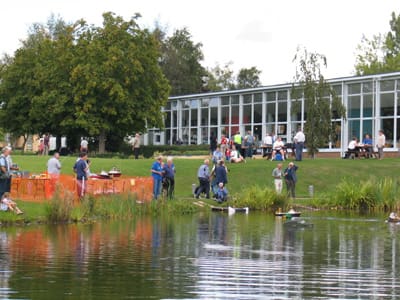
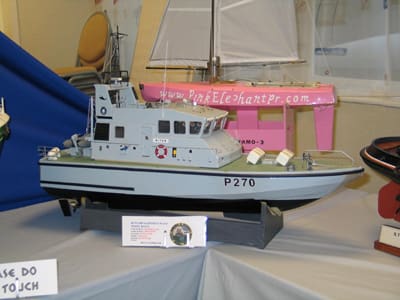
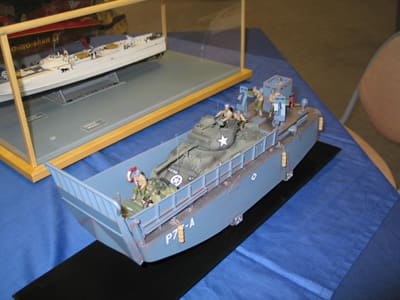
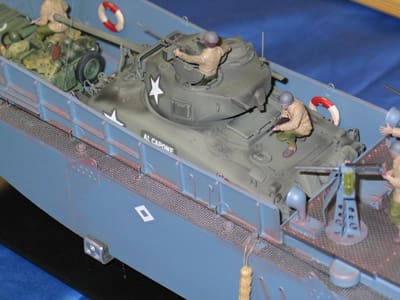
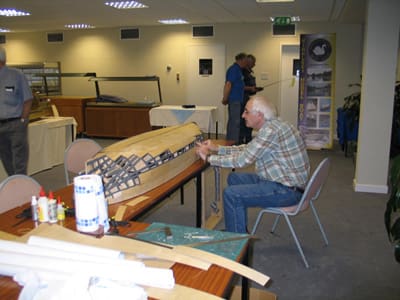
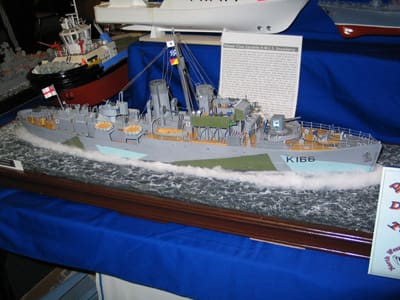
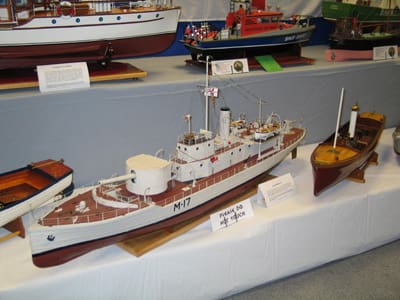
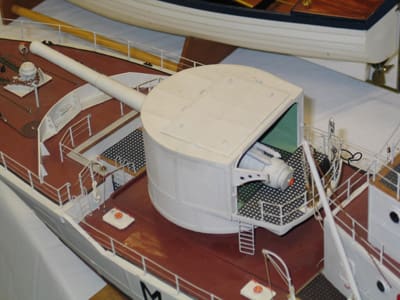
Photo 1 The pleasant surroundings of Birchwood Park, Warrington – halls and lake. Photo 2 A scratch built HMS Biter, an Archer class inshore training squadron vessel. Photo 3 Dave Abbott’s motorised LCM for ‘Plastic Magic’. Photo 4 The Willys Jeep carried aboard the LCM is fully R/C. Photo 5 Model engineer Michael Lee demonstrating hull construction on his 1:48 scale HMS Inflexible. Photo 6 A Revell Flower class corvette fitted into a seascape. Photo 7 The monitor M17 built by John Desborough. Photo 8 M17 is totally scratch built. The tops of the turret open to reveal the workings of the 9.2 inch gun.
Enjoy more Model Boats Magazine reading in the monthly magazine.
Click here to subscribe & save.
The models
As a modeller, being amongst modellers is always a pleasant experience, and there were so many models to choose from, but my brief is warships and warships there were. Photo 2 leads in with a model of the Archer class inshore-training squadron vessel HMS Biter, with the full size vessel being based at Manchester. This particular model is scratch built by Peter Ware.
Perhaps reflecting the popularity of the ‘Plastic Magic’ articles in Model Boats, Dave Abbott brought along a collection of his superb motorised plastic kits, the latest being his model of a small LCM containing a Sherman tank and a Willys Jeep, but more than being just a collection of models the LCM works. The ramp lowers and the jeep can be controlled independently. Dave has applied some superb touches to give this model an authentic appearance, Photos 3 and 4. The model was reviewed in the Kit Special issue of Model Boats on sale on 14th November last.
The first floor was also utilized and given over to clubs and workshop demonstrations. Photo 5 is a good example of this. Here Michael Lee, a model engineer but also a model ship builder, is seen here building up the sides of the hull of his 1:48 HMS Inflexible. Strips of wood are cut, almost like plates and bonded to the framework, which is just visible in the picture. Michael is also building the power plant to the drawings of the original. An ambitious project but one which when completed will produce an extraordinary model.
Almost an iconic model, the Revell Flower class corvette has been through many incarnations over the years, either working or static. Here is one of the latter, an interesting arrangement, Photo 6.
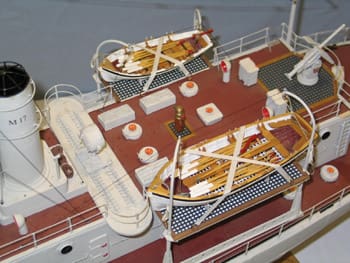
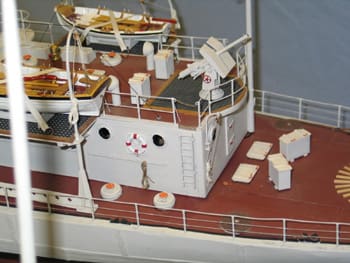
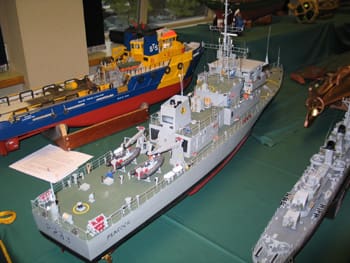
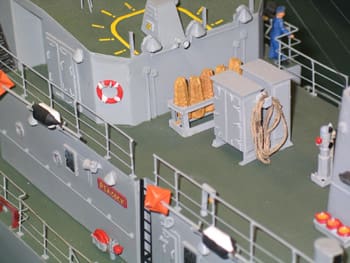
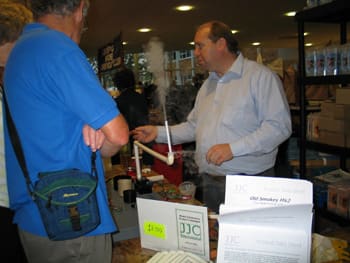
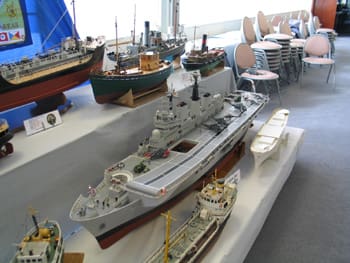
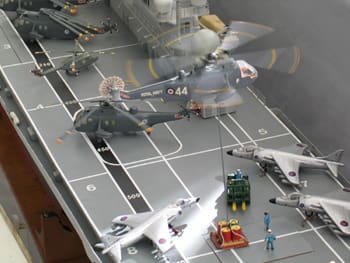
Photo 9 Each of the ship’s boats is built up from cardboard using a wooden plug. Photo 10 The after deck housing and the Hotchkiss 6 pdr. Photo 11 A scratch built HMS Peacock at 1:48 scale. Photo 12 More of the detail on Peacock. Photo 13 JJC Electronics with his smoke generating system. Photo 14 HMS Invincible as seen on the Runcorn Model Boat Club stand features as a popular subject. Photo 15 Large models such as Invincible lend themselves well to accommodating multiple working features such as this working Sea King helicopter.
The M class small monitor recently featured in Model Boats as a build series by Paul Freshney makes for an interesting and impressive model. These series of pictures show M-17 built by John Desborough of the Runcorn Model boat club to a larger scale and based on plans originally made available in Model Shipwright of the M15, Photos 7 to 10. As a matter of interest the hull is made using plank-on-frame and each of the ship’s boats as in Photo 9 is made of Kellogg’s type packaging on a solid wood former, with excellent results.
Another scratch built model is this 1:48 HMS Peacock by Nick Rigby. The hull is built using balsa with plastic card for the superstructure, Photos 11 and 12.
The trade input is always appreciated by modellers and their demonstrations pull in the punters – none more so than JJC with their ‘Old Smokey’ smoke generating unit which I believe uses some principles related to the nebulae, with no noxious fumes. Photo 13 shows a demonstration of this unit which can be coupled to one of JJCs dedicated sound units. There were many clubs displaying both on the first and ground floors. These and other displays will no doubt be covered later by Dave Abbott, however here are just a couple of shots of the Runcorn stand complete with a fully working R05 HMS Invincible, Photos 14 and 15.
Another unusual model caught in the camera lens was a 1:50 scale Saudi Arabian mine warfare ship based on the VT built Sandown class of mine hunters, modelled by Allan Seddon. The hull and many of the fittings are available through PSShips / Sirmar. These Al Jawf type differ in respect to the installation of an Emerlec EX74 gun mounted forward of the bridge, Photo 16. In Photo 17 Ted Scholes is seen putting his amphibious vehicle through its paces on the lake.
Amongst the trade input was Cammett Ltd., showing his developing range of etched frets for his Type 12, Type 41 and 61 frigate semi-kits. A closer look at this range will be dealt with later in this article. Photo 18 shows Cammett’s Type 12 HMS Lowestoft, upper model and the new type 61/41 Salisbury and Leopard or cat class.
Our final picture closes this very brief report with a look at the area of the exhibition. The one very welcome feature was the very practical inclusion of comfortable tables and chairs so you could just relax have a chat and then back into the fray, Photo 19.
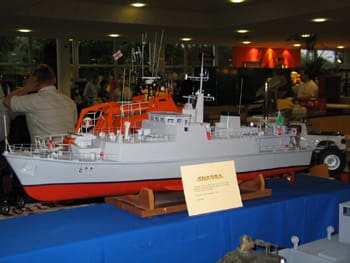
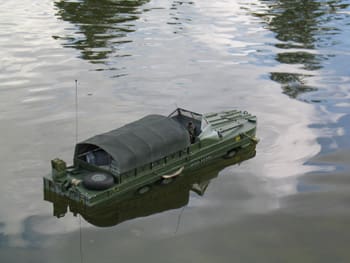
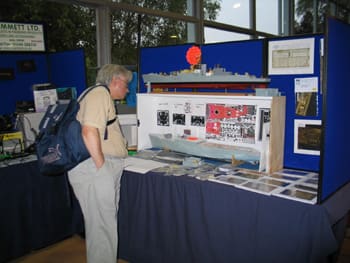
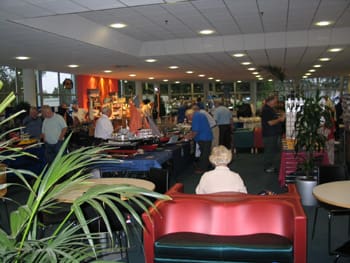
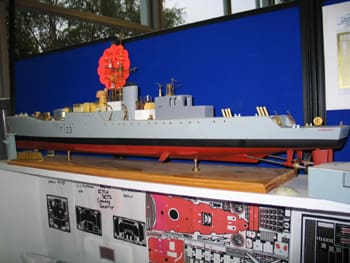
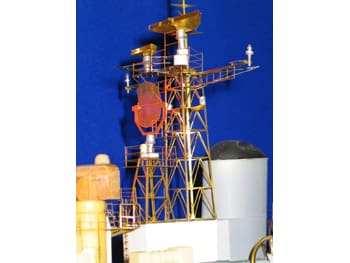
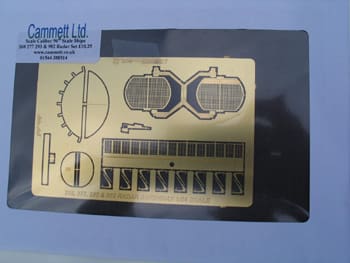
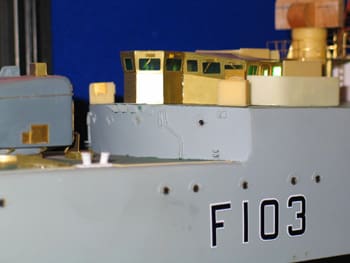
Photo 16 An unusual variation on the Sandown Class mine hunter (see text). Photo 17 From land to lake ,a fully working amphibious vehicle. Photo 18 Cammett Ltd has an increasing range of precision model warships. Photo 19 The venue at Birchwood Park is both light, spacious and comfortable. Photo 20 Cammett’s Type 12 frigate HMS Lowestoft. Photo 21 Lowestoft fitted with a dedicated etched fret or PE for the foremast. Photo 22 Etched frets incorporating the various radar arrays including this fine example of a Type 277 surface search height finding radar. Photo 23 PE frets can be used to reproduce the really fine detail like the wipers above each windscreen on the bridge-housing fret.
Trade Feature – Cammett Ltd
Cammett Ltd has been around for some time but mainly involved in airbrush and spraying equipment. Presently they promote working seminars where modellers can sign up for a day’s tutorial on all aspects of spray painting. Over the past three years they have become interested in developing and marketing a range of grp hulls of RN warships. Along with this additional part of their business Cammett have produced an extensive range of PE (photo-etch) to complement their range of RN hulls. Presently Cammett produce PE frets for the Type 12, Type 41 and Type 61. Photo 20 shows the basic hull, resin superstructure and funnel for the Type 12 frigate. Supplied as part of these semi-kits are the PSShips / Sirmar range of turrets and some deck fittings.
PE Foremast
The assembled PE for the foremast can be seen in Photo 21; at the head of the mast is the Type 293 radar with the smaller Type 974 and on the lower etched lattice mast is the Type 277 (surface search and height finding and low flying detector.
These all come on a single fret and can be seen in Photo 22.
Bridge
The bridge on the Type 12 as made up from PE can be seen on this demonstration model of Lowestoft, Photo 23. This gives some idea of the depth of detail that can be achieved when using dedicated PE. Looking closer at the photo even the fine detail around the window frames is clearly exposed. Photo 24 shows the fret for the bridge.
Turrets
The 4.5 twin turret casting is PSShips / Sirmar whilst the fine details such as the door, ladders and various other fittings seen on the outside of the turret are faithfully reproduced to enhance the casting. Brass turned barrels are also included, Photo 25. Photo 26 shows the original Mk 6 turret as fitted to the Type 12 HMS Plymouth. There are numerous ‘PE packs’ with Photo 27 showing the early director platform which can be just made out abaft of the bridge in this picture of HMS Whitby, Photo 28. Cordage reels can be a problem to scratch. However Cammett have produced a full PE set of the various types and sizes of reels, Photo 29, with Photo 30 showing one type of cordage reel as fitted to Plymouth and the various types of WT doors which can be seen in Photo 31. In the near future there is to be a review of the build of the Type 41 HMS Leopard using much of the PE sets mentioned.
Trade feature – latest Multiplex Cockpit SX 7-channel – Photo 32
Just a glimpse of the latest in synthesizer R/C technology available to boat modellers. There will be more reports on this new era of R/C equipment as the months progress but for now a brief résumé of the very basic capabilities of the Cockpit SX. Like most advances in R/C technology the sets are primarily designed for aeromodellers but have good applications for boats. The question that is now being asked is what is synthesizer R/C? In a nutshell it is an R/C without the plug-in crystals. You select the frequency available on the digital display and it will lock that information into the system. Equally if the need arises any frequency spot in the band (40mHz) can be selected easily.
The core of the unit is IPD or Intelligent Pulse Decoding which enables the signal to be monitored for interference and can suppress interference, only allowing permissible signals through. The set, as you would expect from Multiplex, is superbly balanced, feels comfortable to hold and is physically very thin. Presently the SX comes complete with all the functions – no need for add ons. Although sold with only one servo the plug is of a the type used on most other servos, for example Futaba. More user reports in the near future.
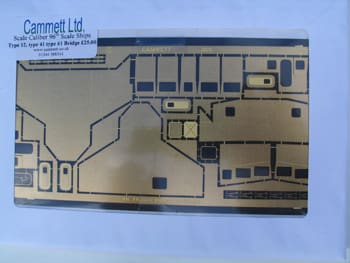
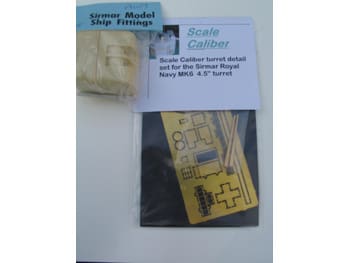
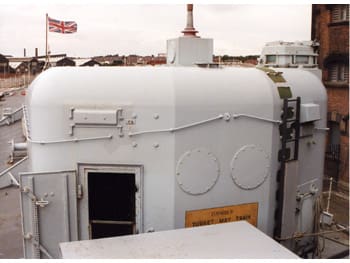
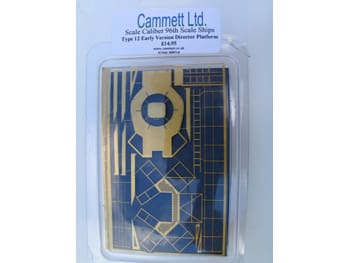
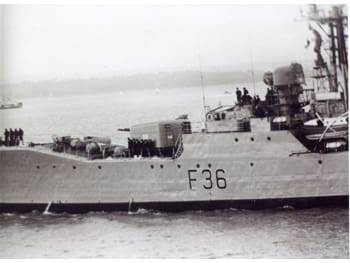
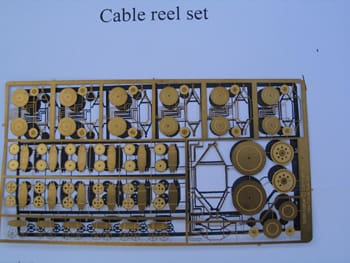
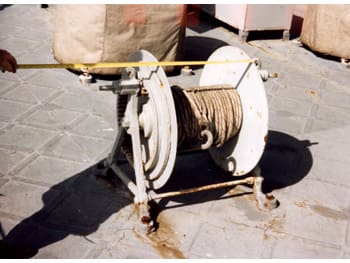
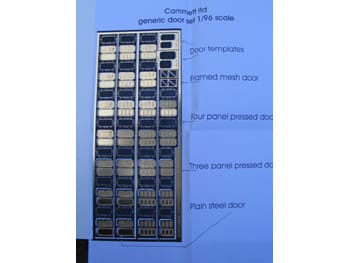
Photo 24 This PE fret to make the bridge housing for the Types 12/41/61s. Photo 25 Cammett produces the detail fret to enhance the PSShips / Sirmar turret moulding – turned barrels included. Photo 26 The Mk6 4.5 inch gunned turret on HMS Plymouth showing many of the fittings sited around the turret housing, see Photo _ 25. Photo 27 The PE frets for the early version director platform for the Type 12-41-61s. Photo 28 In this picture of a Type 12 the director platform is just visible abaft of the bridge. Photo 29 Cammett are striving to produce very comprehensive Photo-etched fittings for their range of models including this cable reel set. Photo 31 An example of the type of deck cable reel as fitted to HMS Plymouth.
An introduction to the Fleetscale 1:96 OPV HMS Mersey
An in depth research photo file on HMS Mersey was published in issues 647-648 and at that time mention was made of a review of the model. At last I can say the model is now completed and a full review of the build will commence in the next issue. This is also intended to coincide with a new publication dealing with full size warships and the building of warship models under the title of ‘Warships and Warship Modelling’. This book also goes into construction on many differing types of warships including that of HMS Mersey.
Much of the detail relating to the original vessel was covered in issue 647 but a brief summary will be helpful. Essentially the Tyne class were designed for the role of fishery protection and are direct replacements for the Isles class of OPVs. Photo 33 shows HMS Severn passing the Liver buildings on the Mersey waterfront. Mersey P283 was the last of the three sisters to be built being launched on 14th June 2003 and entering service in mid 2004, and can be seen here on the day of commissioning at Liverpool Docks, Photo 34.
The Tyne class are reasonably sized vessels and have a displacement of 1,677 tons in a hull 79.75 x 13.60m. Presently all three are leased to the RN for a minimum of five years with the option of a further ten years renewal or returned to the owner/builder. The vessels are designed so the after section can easily accommodate containers and for this a dedicated 25 ton capacity crane is fitted above the deck. The accommodation for the 30 plus crew is good and the hull has been designed to allow a section to be added if the need arises to allow for any increase in crew or equipment. Interestingly Mersey was the last ship to be built at Vosper Thornycroft Woolston shipyard.
Hull preparation
The model is based on a Fleetscale hull and a set of excellent drawings by Jecobin, Photo 35. The hardware shown in Photo 35 is not that eventually installed but was used just for comparison. Photo 36 well illustrates the hull form including the knuckles on this design. Note the positions where the bilge keels are located and exit for the shafts from the hull, also other markings around the hull for wash ports, roller fairlead opening, and anchors hawse opening, Photo 37.
The hull is extremely well moulded and with an almost blemish free surface. However there is a trade off for hulls of this quality and that can be in the thickness of the grp. No bad thing you might say. But in truth quite an amount of effort is needed to reduce the thickness of the inside top edge because this is to form part of the raised bulwark, and as such would require a smooth surface and less obvious thickness appropriate to the scale (1:96). Application of a power sander soon reduces the thickness but otherwise a sanding block will suffice, Photo 38.
With the inside top edge rubbed down the next step is to open up all the wash ports and prepare for the installation of the shafts. Here care should be the order of the day as there is always a possibility when drilling out that small flakes of gel coat can become detached and head straight for the eyes. So a pair of safety goggles is a good investment. To reduce some of the problems of drilling into grp I have found that plain electrical tape over the area to be drilled helps to lessen the prospect of bits coming loose. This also reduces problems of the drill bit slipping or the gel coat shattering, particularly when drilling portholes. Once the openings have been made and suitably shaped, a not too coarse file will do the rest if the opening needs to be enlarged or shaped as in wash ports, Photo 38.
Next month – installing the running gear, rudders, motors and r/c equipment.
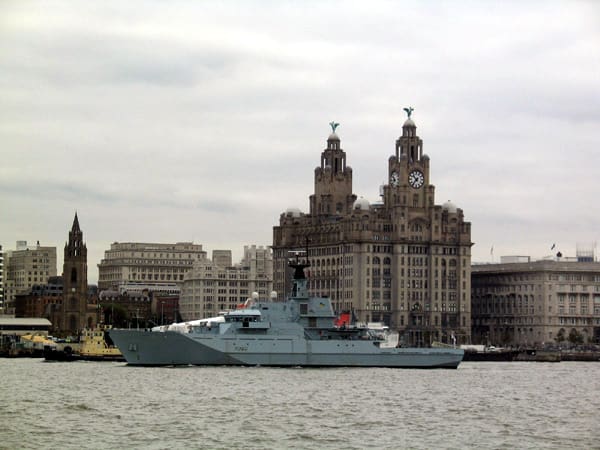
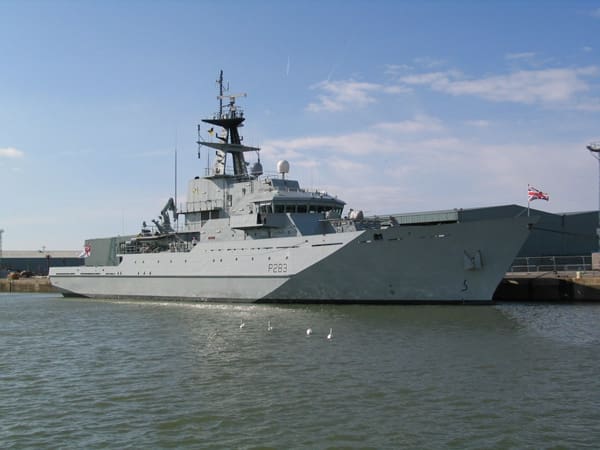
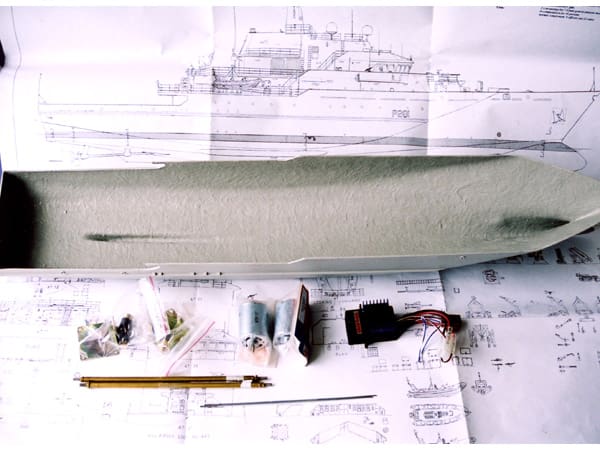
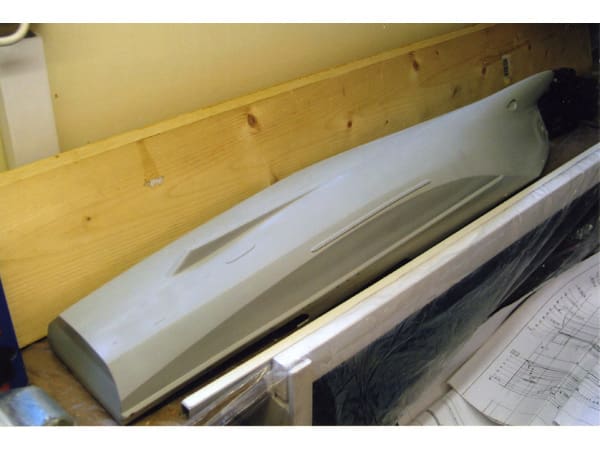
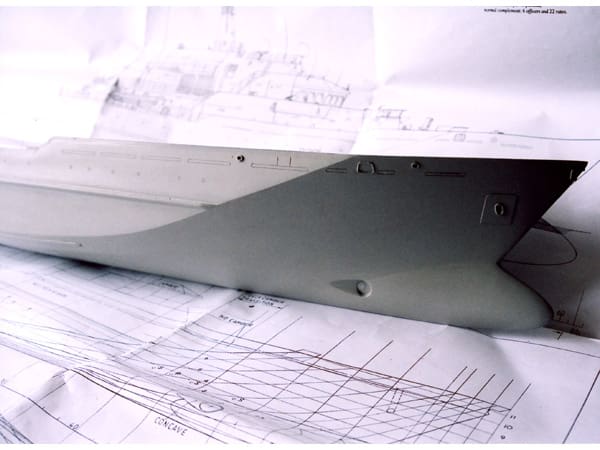
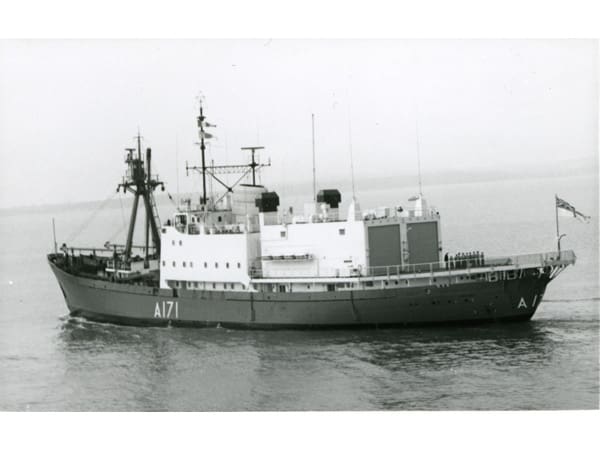
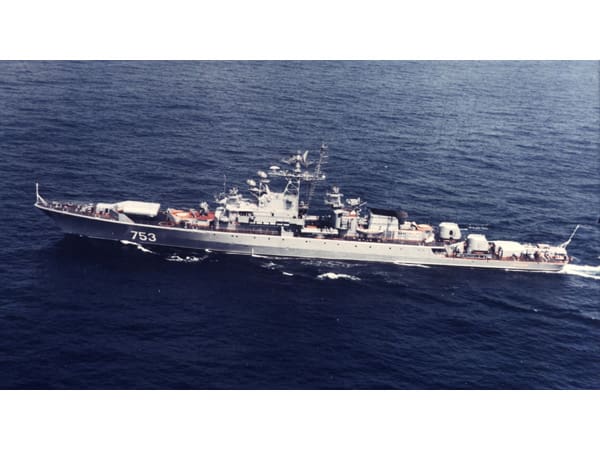
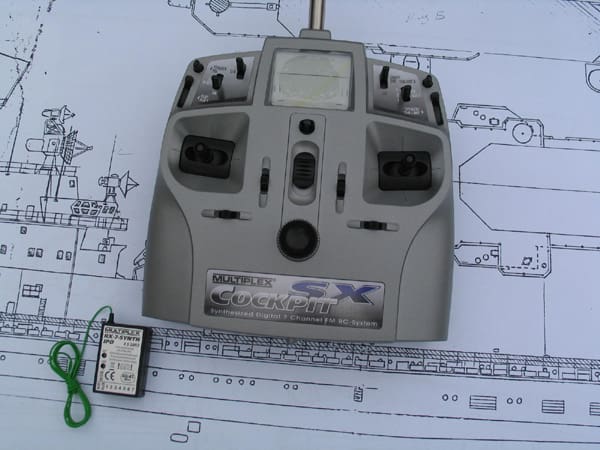
Photo 32 A truly superb watertight door PE set. Photo 32 HMS Severn, a Tyne or River class OPV passing the Liver buildings at Liverpool. Photo 33 HMS Mersey in pristine condition on commissioning day. Photo 34 Fleetscale’s superbly moulded 1:96 scale River Class grp hull. Photo 35 All the complex shapes are moulded into this Fleetscale hull. Photo 36 Openings around the hull are clearly marked. Photo 37 The inside top edge of the hull has to be rubbed down to achieve a smooth surface and reduce the thickness. Photo 38 This month’s mystery picture? Photo 39 What type of ship are we looking at? Photo 40 Synthesized digital technology. The next generation of R/C equipment for the warship modeller.
Answer to last month’s issue (673) Mystery Picture – HMS Medina
Just to revive your memories from last month the clue was ‘named after a religious site’. This was more a cryptic clue as the class of 12 vessels were all named after rivers. However this particular Mystery Picture was certainly not an easy one it was in fact the flat-iron gunboat Medina.
These 386 ton vessels were very different from the more popular (for modellers) Ant class insomuch as the Medina was fitted with a full Brigantine rig – although Conrad Dixon in his book ‘Ships of the Victorian Navy’ makes the point that the masting arrangement resembled that of a three-masted barquentine. Built at Palmers in Jarrow in 1876 and unlike the Ant class, Medina had two 64 pdrs well forward which could be pivoted through 80 degrees from the centre line. There was also a 64 pdr sited right aft. The vessels were 110ft in length by 34ft in beam with Medina serving the gunnery school at HMS Excellent, and a stint on the West Indies Station, eventually being hulked and disposed of in Bermuda in 1904.
Answer to last month’s issue (673) What Type of Ship Are We Looking At? – Troopship Crocodile
Like the Mystery Picture this little brainteaser was also difficult, but to answer the original question, the vessel depicted was the Indian Troopship Crocodile. In the mid part of the 19th century there became a need for dedicated troop transports, particularly those forces destined for the Indian sub-continent. Five such vessels were built and operated by the Indian Government. At 360ft in length and over 6,200 tons they were quite substantial ships for the period, fitted out to transport not just troops but also their dependents. Before the building of the Suez Canal a sort of shuttle service was in operation whereby Crocodile and one of her sister ships would go as far as Egypt with three other troopers providing the on-going service from Egypt to Bombay, India.
This month’s Mystery Picture – Photo 39
Can you identify this vessel? An easy one for this month so no clues.
This month’s What Type of Ship Are We Looking At? – Photo 40
Clue, this ship is classed as an FFG.
Also in preparation for next month are the first pictures of the almost completed Batch Two River Class OPV HMS Clyde, plus a review of the new Warship Pictorial on the Arleigh Burke class DDGs.
References and Acknowledgements
Flat-iron gun boat Medina ref. Ships of the Victorian Navy by Conrad Dixon. Troop Ship Crocodile ref. Ships of the Victorian Navy by Conrad Dixon. Conway’s All The World’s Fighting Ships 1860-1905.



